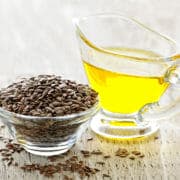What is the Safest Form of Flaxseed – Whole, Ground, Heat Treated or Oil?
Confusion around what form of flaxseed (linseed) is best/safest to feed our horses is nothing new. While many of us thought the concerns around cyanide poisoning for horses were laid to rest, recent safety issues around flaxseed supplementation in human diets, more specifically for toddlers and children, has warranted us to look at this again (EFSA CONTAM Panel, 2019).
There are very few published research studies available in horses around the safety of feeding flaxseed. And there are no published reports of cyanide poisoning that we are aware of. Most safety information is extrapolated from other species including humans, rats, dogs, cattle and pigs. Although information is limited, we aim to answer three questions for you:
- Should we be concerned about the potential of cyanide poisoning in horses?
- What is the safest form of flaxseed to feed our horses?
- Does form then affect the fatty acid composition of flaxseed?
How is flaxseed commonly fed to horses?
Currently, whole and freshly ground flaxseed are the most common ways of feeding flaxseeds to our horses.
Whole flaxseeds are deemed relatively safe from the point of view of cyanide poisoning as the two things (more scientifically, the precursors for cyanide production; cynanogenic glycosides and the glycosidase enzyme) that combine to produce cyanide are contained separately within the intact whole seed. Once eaten, the chewing action grinding the seeds can allow for cyanide production, but it is thought that this is quickly halted once the flaxseed reaches the stomach and the enzyme becomes deactivated by the gastric acid.
Anecdotally horse owners have found that whole flaxseeds can pass undigested through the gastrointestinal tract presenting in manure, with some finding flaxseed plants growing in their paddocks (great for biodiversity in the pasture, but not so much benefit to our horse in getting those added fatty acids in the diet as we had hoped).
Freshly ground flaxseed has become popular for this reason – with limited time for cyanide to form, preservation of fatty acids and to ensure our horses could access all the goodness within the seed coat freshly ground flaxseed is an excellent option.
Realistically, what is the likelihood of cyanide poisoning in horses?
It appears not likely.
Extrapolated from other species, a horse’s maximum ‘safe’ intake of cyanogenic precursors is 0.4mg/ kg body weight… or 200mg for a 500kg (1100lb) horse (Dusica, I. et al., 2012).
So, even if a flaxseed product contained the highest concentration of cyanogenic precursors reported in the European Food Safety Authority database (407mg/kg) (EFSA CONTAM Panel, 2019), it can be still be safely fed at up to 500g (~1 lb) per day for a 500kg horse.
How much flaxseed can I feed safely?
There is no established recommendation, but we can be guided by amounts that have been safely fed in a few horse-specific studies.
In a Canadian study, horses were fed 100g (3.5 oz) per 100kg (220 lb) body weight per day (500 grams for a 500 kg horse). This study looked at the supplementation of flaxseed for reducing skin reactions like ‘sweet itch’ (O’Neill, W. et al., 2002). The authors reported no negative effects of feeding milled flaxseed at this level and reported reduced skin reactions in response to the induced skin irritation in the flaxseed supplemented horses.
Other studies in 2009 & 2012, fed a much lower amount of milled flaxseed, estimated to be 150-165g (5.5-5.8 oz) per day. Between these two studies, positive changes in blood and muscle omega 3 content and improved immune function were reported in those supplemented with flaxseed compared with control groups (Vineyard, K. et al., 2009; Hess, T. et al., 2012).
Based on these few studies and figures extrapolated from other species, up to 100g (3.5 oz) per 100kg (220 lb) or 500 grams for a 500 kg horse per day can be fed safely.
Most horses (65% according to Facebook Poll conducted on the 15 October 2020 by FeedXL Horse Nutrition Calculator) receive 100-250g (3.5-8.8 oz) flaxseed per day.
If you are concerned about cyanide toxicity, what can you do?
Research has shown that heating flaxseed can reduce the amount of cyanogenic precursor present.
One study showed microwaving flaxseed for just over 4.5 minutes on microwave power of 400W reduced precursor by 25% (Dusica, I. et al., 2012). Beware though, you can burn flaxseed in the microwave! Microwave power > 560W for 6 minutes caused samples to burn.
Other studies have also shown that microwave roasting achieved the highest level of precursor reduction (83.3%) in flaxseed (Feng et al. (2003).
Happily, this study also showed that there were no major changes in the main nutrient and fatty acid profile caused by microwave treatment.
Similarly, extrusion (140 degree Celsius) significantly reduced cyanogenic compounds (84%) but did not significantly change the fatty acid content – even after storage for 60 days (Imran, M et al., 2015). Limited information is available on micronized flaxseed specifically.
Interestingly, the perception that fatty acids in raw ground flaxseed deteriorate quickly is not supported by various studies, all showing minimal difference in fatty acid composition after 2-4 months storage (Khalesi, S., et al. 2011).
What about oil?
The good news is that oil doesn’t contain the cynangenic compounds of whole or ground flaxseed. It can be less stable in terms of fatty acid composition, therefore must be stored correctly and used in a timely manner. But if the reason you are feeding flaxseed is for the oil content, then using the oil may be an option worth considering.
With flaxseed oil products though, you do not get the benefit of other nutrients whole, ground or milled flaxseed provides to a diet including like protein, fibre, minerals & vitamins.
Summary
So, are we any closer to knowing what is the best and safest form of flaxseed to feed our horses? Honestly, we think it comes down to personal preference.
With cyanide toxicity appearing to be less of an issue for horses due to the low amounts commonly fed in comparison to body weight – whole or ground flaxseed is acceptable. Due to anecdotal evidence of whole flaxseeds passing undigested through the gut, freshly ground flaxseed is favourable to ensure fatty acids can be absorbed.
Ground flaxseed also offers the benefit of providing the wonderful fibre and other nutrients along with the omega 3 fatty acids compared with flaxseed oil.
Practically, freshly grinding flaxseed is not for everyone. If this is the case for you, using a stabilised (pre-heat treated) flaxseed product may be a better option.
If you are still concerned about cyanide poisoning, microwaving your flaxseed should significantly reduce the cyanogenic precursor and is unlikely to affect the fatty acid content. Be careful microwaving though to make sure you are not burning the flaxseed.
And do your own research on the safest way to microwave them based on your specific microwave. As a guide you should be able to safely microwave them at 400W for 5 minutes. But the quantity you microwave at any one time will have an effect on the appropriate time you should use.
Feeding rates will vary depending on a horse’s energy requirement and amount of omega 3 within the diet however up to 100g per 100kg body weight appears safe…the economics of feeding this much we are less sure about!
References
Dusica, I., Kokic, B., & Tea, B., Colovic, R., Vukmirovic, D. & Slavica, S. (2012). Effect of microwave heating on content of cyanogenic glycosides in linseed. Ratarstvo i povrtarstvo. 49. 63-68.
EFSA CONTAM Panel (EFSA Panel on Contaminants in the Food Chain), Schrenk, D., Bignami, M., Bodin, L., Chipman, J.K., del Mazo, J., Grasl‐Kraupp, B., Hogstrand, C., Hoogenboom, L.R., Leblanc, J‐C., Nebbia, C.S., Nielsen, E., Ntzani, E., Petersen, A., Sand, S., Vleminckx, C, Wallace, H., Benford, D., Brimer, L., Mancini, F.R., Metzler, M., Viviani, B., Altieri, A., Arcella, D., Steinkellner, H. & Schwerdtle, T., (2019). Scientific opinion on the evaluation of the health risks related to the presence of cyanogenic glycosides in foods other than raw apricot kernels. EFSA Journal 2019;17(4):5662, 78.
Feng, D., Shen, Y. & Chavez, E. (2003). Effectiveness of different processing methods in reducing hydrogen cyanide content of flaxseed. Journal of the Science of Food and Agriculture. 83. 836 – 841.
Hess, T., Rexford, J., Hansen, D. Harris, M., Schauermann, N., Ross-Jones, T., Engle, T., Allen, K. & Mulligan, C. (2012). Effects of two different dietary sources of long chain omega-3, highly unsaturated fatty acids on incorporation into the plasma, red blood cell, and skeletal muscle in horses. Journal of Animal Science. 90. 3023-31.
Imran, M., Anjum, F., Ahmad, N., Khan, M., Mushtaq, Z., Nadeem, M. & Hussain, S. (2015). Impact of extrusion processing conditions on lipid peroxidation and storage stability of full-fat flaxseed meal. Lipids in health and disease. 14. 92.
Khalesi, S., Jamaluddin, R. & Ismail, A. (2011). Effect of raw and heated flaxseed (Linum usitatissimum L.) on blood lipid profiles in rats. International Journal of Applied Science and Technology. 1(4). 84-9.
O’Neill, W., McKee, S. & Clarke, A. (2002). Flaxseed (Linum usitatissimum) supplementation associated with reduced skin test lesional area in horses with Culicoides hypersensitivity. Canadian journal of veterinary research = Revue canadienne de recherche vétérinaire. 66. 272-7.
Ratnayake, W., Behrens, W., Fischer, P., Labbe, M., Mongeau, R. & Bearerogers, J. (1992). Chemical and nutritional studies of flax-seed (Variety Linott) in rats. Journal of Nutritional Biochemistry. 3. 232-240.
Vineyard, K., Warren, L. & Kivipelto, J. (2009). Effect of dietary omega-3 fatty acid source on plasma and red blood cell membrane composition and immune function in yearling horses. Journal of Animal Science. 88. 248-57.
Meet The Author: Samantha Potter, MSc

In 2009, Sam completed a Bachelor of Equine Studies and it was during this time she developed an interest in equine nutrition. Pursuing this passion, Sam went on to complete her Honours followed by her Masters degree in equine nutrition at The University of Melbourne. Since 2015, Sam has worked as an independent nutritionist and enjoys supporting horse owners manage their horse’s nutrition in her role with FeedXL. To learn more about Sam and to ‘meet’ the rest of the FeedXL team, check out our About Us page here.
Do you have a question or comment? Do you need help with feeding?
We would love to welcome you to our FeedXL Horse Nutrition Facebook Group. Ask questions and have them answered by PhD and Masters qualified equine nutritionists and spend time with like-minded horse owners. It’s free!
Click here to join the FeedXL Horse Nutrition Facebook Group




